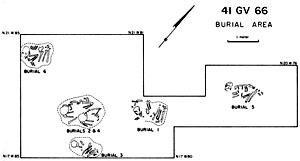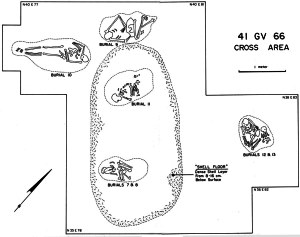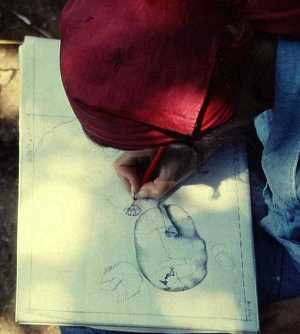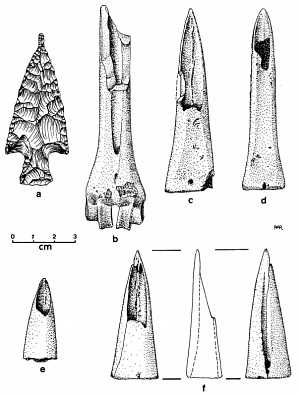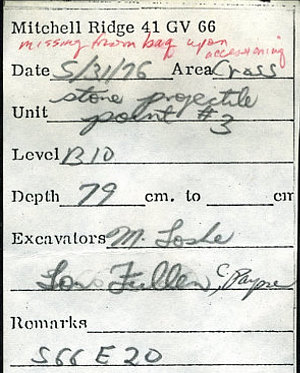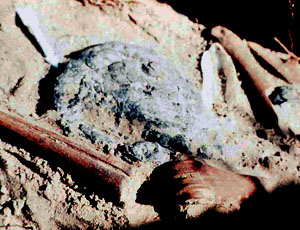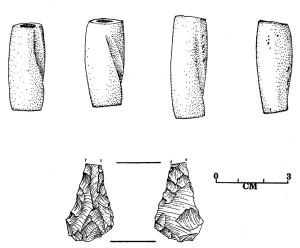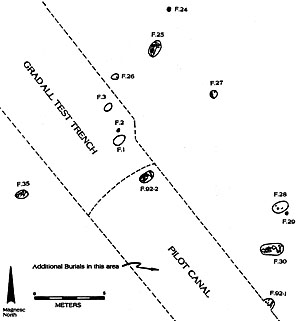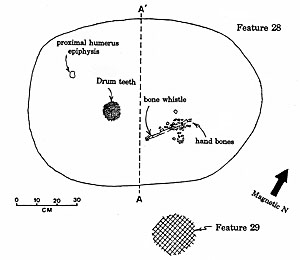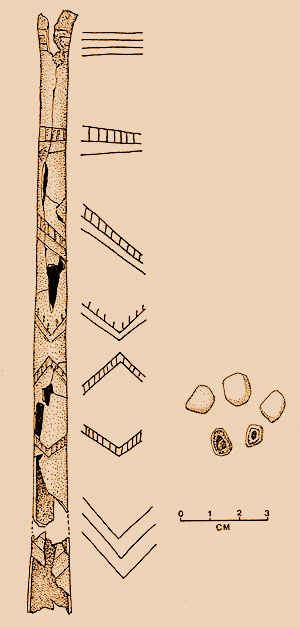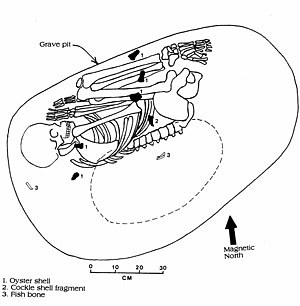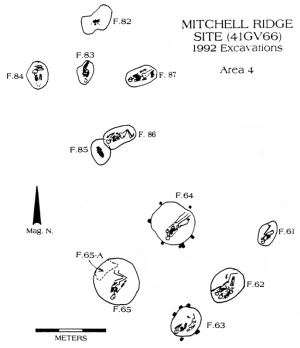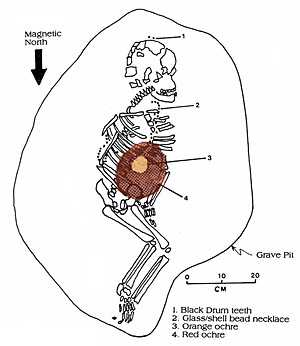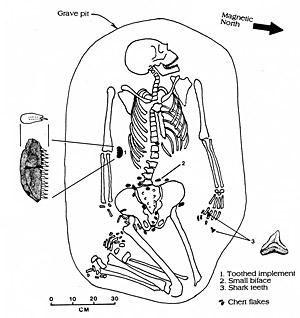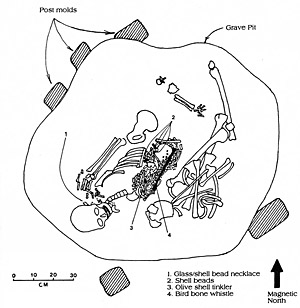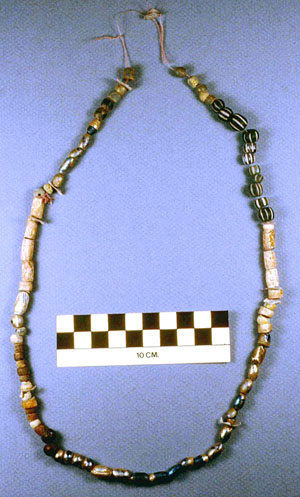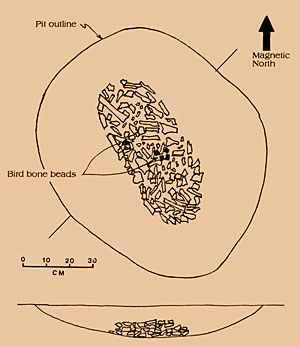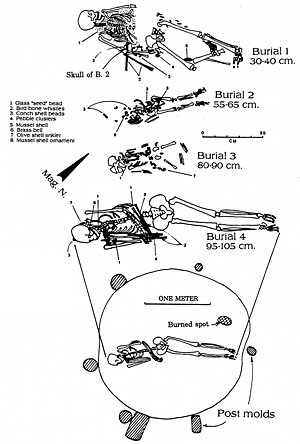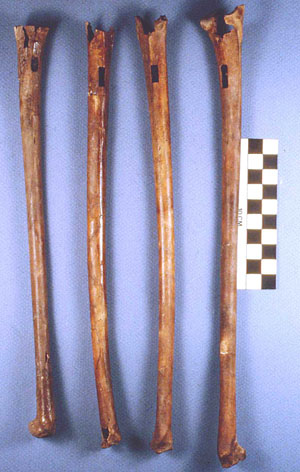Mortuary Patterns
Mitchell Ridge site map highlighting the location of the four cemeteries and one isolated burial documented by archeological investigation. |
|
The Mitchell Ridge has the distinction of having the largest scientifically documented burial "population" of native peoples known from the upper Texas coast. The remains of at least 56 individuals were recovered from the Mitchell Ridge site. With the exception of one isolated grave, all burials occurred within one of four clusters that seem to represent small discrete cemeteries. With a single exception (not the same one), the burials are thought to date to a 1000-year span of time from approximately A.D. 800 to 1800 covering the four periods, Initial Late Prehistoric, Final Late Prehistoric, Protohistoric, and Early Historic outlined in the Chronology section. The four cemeteries do not neatly correspond to the four chronological periods. Instead, each cemetery contained individuals dating to at least two periods. This is one of several lines of evidence that demonstrate cultural continuity – Mitchell Ridge represents a fascinating mortuary tradition. Here we summarize the in-the-ground mortuary patterns as they were archeologically documented. The significance and scientific interpretation of the Mitchell Ridge mortuary tradition is discussed at some length in the Life and Death section. Serious students of archeology can also download Chapter 8 from the site report to study details. Two of the four known cemeteries at Mitchell Ridge were investigated during the 1970s in the excavation areas known as the “Burial Area” and the Cross Area.” Although photographs and recollections show that the encountered burials were carefully excavated and documented, most of the field records are missing. Fortunately, surviving field maps provide location and orientation for most of the interred individuals, and the human remains and most of the associated grave goods are properly curated at TARL. The missing records and the uncertainty is one of the unfortunate results of the “Galveston Historical Museum fiasco” discussed in the Investigations section. The other two cemeteries at Mitchell Ridge were investigated in 1992 in the mechanically-bladed areas known as “Area 1” and “Area 4.” The Area 1 cemetery was initially encountered in early 1992 during the machine dredging of a pilot canal for the planned residential development. The dredging was halted when human remains were encountered, an event which led to the extensive 1992 investigations. The Area 4 cemetery is the only one of the four was completely excavated and documented. Burial Area CemeteryIn this area five graves, one of which held two individuals, were documented during the 1970s excavations. As the plan map makes plain, the cemetery almost certainly extended beyond the boundaries of the excavated area. Radiocarbon assays were obtained on bone samples from two of the Burial Area graves. Burial 4 dated to around A.D. 970 during the Initial Late Prehistoric period, while Burial 3 dated to around A.D. 1300 during the Final Late Prehistoric period. All six of the interred individuals in the Burial Area cemetery were buried in flexed or semi-flexed positions (legs and arms bent). Three burials were that of adult males, one of them more than 50 years old, two burials were that of adult females, one of which was also over 50 years old, and the sixth burial was that of an adolescent female 11-15 years old. Burials 2 and 4 were placed side by side within a single burial pit. The fact that the skeletons did not intrude into one another suggests that the two individuals were interred at the same time. Burial 5, that of an adult female 20-50 years of age, was accompanied by a single grave object, a small engraved and shaped rectangular bone artifact that may represent a gaming piece. None of the other burials in this cemetery had grave offerings. Cross Area CemeteryFive graves, two of which held two individuals, were documented in this area during the 1970s excavations. As is the case for the Burial Area cemetery, it is likely that additional burials were present beyond the limits of the excavations. The Cross Area cemetery appears to have accumulated during two different intervals of time separated by at least 700-800 years. There is also considerable variation in body position and grave contents. Given this variation, several of the burials are described in some detail. Burial 10, that of a young adult male 20-25 years old laid out in a fully extended position, is the oldest burial at Mitchell Ridge, radiocarbon dated to around 2,000 years ago in the first century A.D. This date falls at the end of the Preceramic period or the earliest part of the Early Ceramic period as defined locally. Viewed from a larger regional perspective, Burial 10 fits within the Late Archaic burial tradition given its dating, array of grave offerings, burial position, and northeastern headward orientation, which is different from all other burials at the site. At least sixteen grave offerings were found with Burial 10 including a Godley dart point, seven socketed bone points, four unworked distal ends of deer metapodials (foot bones) thought to represent a manufacturing blank for the socketed bone points, a piece of pumice, a modified deer ulna (lower leg bone), and two shell scraping tools. Lou Fullen who helped excavate Burial 10 in late May and early June, 1976, distinctly recalls an additional dart point and, perhaps most intriguingly, a small mass of asphaltum with sharply defined rounded edges and fiber impressions suggesting it may have been held within a woven pouch. These artifacts were not among the materials turned over for curation. As the accompanying photos show, there are two surviving bits of evidence of the missing artifacts. One is an original laboratory bag tag marked “stone projectile #3” (although recollections and Atkin’s manuscript suggest that only two dart points were associated with the burial). The other is a poorly exposed and focused photograph that seems to show a dark-colored, rounded mass (perhaps 10 cm across) above the chest along side a deer metapodial socketed point and a medipodial blank. The other six burials were those of three children, a teenage girl, an adult female, and an adult male. Burial 7 (adult male) was accompanied by three conch columella beads, a small chert drill base, and a chert flake. Burial 12 (teenage girl) was interred in a semi-flexed position lying on her back. In the chest area were two Scallorn arrow points, one of which was found during analysis—it was embedded in the third lumbar vertebra. The other point was also found near the spinal column, suggesting that the young woman died a violent death—shot in the back. Similar mortuary evidence in many areas of Texas suggest that the Initial Late Prehistoric period was a time of widespread violence, perhaps because of territorial expansion and competition. The “shell floor” was an oyster shell lens that overlay three of the burials. When the shell lens was recorded, it was speculatively identified as the floor of a house. Atkins noted that “scattered throughout the shell were small food [animal] bones, sherds, and a few lithic tools in no apparent pattern.” The Cross Area cemetery was within the area of the site with dense occupational debris. The oval shape of the shell lens is intriguing, but there is no other supporting evidence of the notion it represents a house floor. Without such evidence, such as postmolds and an associated hearth, it is far from certain that the lens represents the floor of a structure. While is possible that the shell layer was intentionally placed to cover the two graves that it overlays, this pattern was not see elsewhere at the site. Oyster shell “midden” layers were found in other areas of Mitchell Ridge and it may well be that the Cross Area shell lens merely represents a concentration of discarded food remains. Area 1 CemeteryA discrete cluster of 10 burial pits containing 13 individuals was documented in Area 1 following the pilot-canal dredging event that triggered the 1992 archeological investigations. An additional five individuals (four adults and one juvenile) were identified from bone fragments recovered from the dredging backdirt. Thus, the Area 1 cemetery contained at least 18 individuals. Although it is possible that the dredging operation may have removed a few others, the subsequent machine stripping and archeological excavations clearly determined the limits of the cemetery. Radiocarbon assays on samples from four of the Area 1 burials show that this cemetery may have been in use over a six or seven-century span, from the Initial Late Prehistoric period, around A.D. 1000, into the late Protohistoric or Early Historic periods in the 1600s and 1700s. The Area 1 burials were locating by defining dark pit outlines in the surface of the light-colored sand/shell hash matrix into which the burial pits had been dug. Two probable aboriginal dark-stained features, Features 1 and 2, did not contain human bone. Their function is unknown, but could well be related to the cemetery given their proximity to several burials. The 13 individuals in the 10 well-documented graves were treated in a remarkable variety of ways and included men, women, and children. Only five were primary burials, four in semi-flexed positions and one fully extended. Two burials were cremations. Two others were secondary burials, meaning that the bones were jumbled and presumably reburied from another location. Four individuals were “token” burials, two of which were represented by single patellas (kneecaps), while two were represented by arm and hand bones. The potential meaning of this unusually diverse pattern of burial treatment is discussed in the Life and Death section. Grave offerings were found with only two of the Area 1 burials. The Feature 30 grave of an adult female was accompanied by a rectangular piece of freshwater mussel shell. Although the shell was poorly preserved, it was found in the neck area and probably represents a pendant. The Feature 28 grave contained the token remains of two juveniles of unknown gender accompanied by a whooping crane ulna whistle and a small circular mass of over 350 black drum fish teeth. The tight cluster of teeth suggests that they had been contained in a circular container organic container, no traces of which survived. A reasonable explanation is that the drum teeth were part of a rattle made from a dried gourd or hollowed out piece of wood. A similar interpretation has been made for a concentration of pebbles and drum teeth found in a grave at the Harris County Boys School site on the west shore of Galveston Bay. The delicate whooping crane whistle or flute was crushed by ground pressure, but its form could be seen during excavation and enough fragments could be pieced together to show the basic design. The sound hole was not preserved, but can be inferred because of the strong resemblance of this artifact with other whistles and flutes at Mitchell Ridge and other upper coastal cemeteries. See discussion of this and similar artifacts in Grave Goods . The token human remains consisted of hand bones around the whooping crane whistle and the unfused ends (immature) of two arm bones. The meaning of such partial burials is discussed in Life and Death. Area 3 Isolated BurialThe only isolated grave found at Mitchell Ridge was found along the ridge to the south of the main occupation area of the site. The Feature 52 grave held a tightly flexed adult male 30-50 years old, elderly for most hunter-gatherers. As can be seen in the accompanying illustration, the deceased was placed up against the northwest side of the grave pit, leaving an open area on the southeast side in which was a sizable area of organically stained soil containing numerous fish and cotton rat bones. These bones and 14 oyster shells, Atlantic cockle, a small lightening whelk, and a marsh periwinkle very likely represent food offerings. Judging from the diversity of species and the number of individual animals represented by the recovered bone, as well as the size of the dark, organically stained area, a considerable quantity of food was placed in the grave. A radiocarbon assay suggests this interment dates to about A.D. 1300, at the end of the Initial Late Prehistoric period. Area 4 CemeteryThe most extraordinary and informative of the four cemeteries at Mitchell Ridge, the Area 4 cemetery is the only one we can be certain was completely documented. During the 1992 work the entire area surrounding the clustered grave pits was completely exposed and carefully searched for additional burials. Eleven grave pits, containing the remains of at least 24 individuals, were found in a discrete cluster measuring some 8 by 15 meters in Area 4. This is the largest of the Mitchell Ridge cemeteries and, like Area 1, it contained a diverse burial population in terms of age, gender, number of individuals per grave pit, and interment treatment. It also contains the latest and most elaborate graves with the highest incidence of grave offerings, suggesting that Area 4 held relatively high-status individuals, some of whom were of mixed ancestry including several who had European skeletal features. In age the deceased range from over 50 years old to newly born. Of those for which gender could be determined, there were five females and six males. Most were primary burials in flexed or extended positions, but there were also three token burials and four secondary cremations (burned bone and ash from cremation events that took place elsewhere). Six of the grave pits held multiple individuals, including six in Feature 63, and there is clear evidence that some of the burials were interred in a single grave pit in different episodes. Because of the complexity of treatment, reuse of several grave pits, and varying degrees of bone preservation, there may have been several more than 24 individuals who were interred in the Area 1 cemetery. In contrast to all other cemeteries at Mitchell Ridge, all but one of the grave pits in the Area 4 cemetery held grave offerings. Only the single individual in Feature 84 and one of the six individuals in Feature 63 were clearly unaccompanied by offerings. Radiocarbon dates show that the Area 1 cemetery began to form in the Final Late Prehistoric period. Other radiocarbon assays and the inclusion of glass and/or metal artifacts in six of the grave pits show that burials continued during the Protohistoric followed by the main period of use during 17th and early 18th centuries during the Early Historic period. Here we briefly describe four of the Area 4 cemetery graves, and note again that other dimensions of the mortuary patterns are discussed in the Grave Goods and Life and Death sections. Each of the eleven graves provided important data, as are detailed in the site report. The Feature 83 grave was that of a single individual, a child 4-8 years of age who was accompanied by a wealth of grave goods. The gender of the child is unknown. The most prominent and unusual offering was the placement of concentric pattern of powdered yellow ochre surrounded by red ochre powder placed on the lower abdomen. This pattern, thought to be a solar symbol, is used in this exhibit as an icon for the Mitchell Ridge site, symbolizing its identity as a burial ground. The child interred in the Feature 83 grave pit was placed on its back (or side) with legs slightly bent to one side and both hands placed over the pelvis. The solar pattern was placed atop the body in the stomach area. Around the child’s neck was a necklace made of 14 turquoise blue glass trade beads, each of which was separated by one or two short tubular shell beads, made from conch columella. The beads were of the most common 16th to 17th century trade bead style and were probably manufacturing in Europe prior to 1680. The final offering consisted two black drum molars found near the crown of the child’s head. Given that drum teeth found in other graves were thought to be rattles from a musical instrument, it is possible that the two molars were placed in a small container of perishable material tied in the child’s hair and mean to make a rattling sound. A grave pit designated Feature 87 held another single interment accorded special treatment. This adult male, 35-39 years of age, was placed in a semi-flexed position with tightly bent legs and accompanied by a fascinating set of offerings. Clustered around the lower abdomen and pelvis were nine stone tools made of chert including two complete and one fragmentary small bifaces, a small retouched flake shaped like a scraper, and five simple flake tools with use-damaged edges. One of the bifaces had asphaltum adhering to one end, suggesting it had been set within a wooden handle or shaft and made represent a blunt projectile tip of the sort used to kill or stun small mammals or fish by impact. The most unusual grave object, however, was resting next to the elbow of the man’s extended right arm. A small oblong mass of asphaltum formed a handle into which 13 sharpened hispid cotton rat incisors were set in a single row. A similar artifact is revealed to be a shaman-curer’s bloodletting tool in the historic account of Jean-Baptise Talon, a French boy captured by Karankawas at La Salle’s Fort St Louis in 1687 and lived with a group of Karankawa along the Texas coast four years.
Resting near the fingers of the man’s left hand were two shark teeth which have sharp serrated edges and may well represent bloodletting tools as well. The array of cutting tools in the grave, at least one of which is almost certainly a bloodletting tool, strongly hint that the man in the grave was a shaman or curer. The most internally complex grave pit at Mitchell Ridge was Feature 63, an Early Historic grave containing the remains of at least six individuals ranging in age from infant to mature adult. This relatively large pit about 1.5 meters (5 feet) in diameter that was partially surrounded by five large post molds, readily recognizable by their shape and by the brown sandy fill that stood out in contrast to the surrounding light tan sand/shell hash. All six posts molds were square to rectangular in outline, in marked contrast to the circular post molds found in almost all prehistoric structures that have been documented in Texas. The unusual outline shapes strongly suggests the posts had been fashioned from square-hewn timbers like those found on the Spanish and French sailing vessels known to have wrecked along the upper Texas coast in the sixteenth through eighteenth centuries. (See La Belle exhibit on the most famous shipwreck known from the region.) As further discussed in the Life and Death section, the posts around Feature 63, like those around nearby Feature 64, are unique among known cemetery sites on the upper Texas coast. The post-ringed graves would have stood out among all others at the Mitchell Ridge site. The six individuals in the Feature 63 grave were interred in four different modes of burial: primary, secondary, secondary cremation, and secondary token burial. The six burials took place in several different events. The first interment was that of a robust adult male, 20-25 years of age who was placed in a semi-flexed position, resting on his back with the left arm bent at the elbow and the left hand drawn up next to the face. Sometime later many of the man’s bones were pushed aside when the grave pit was reopened and a burial bundle was added containing the remains of four individuals, two of which had been cremated. The compact mass of bundled bones were found within a narrow rectangular in shape, suggesting that the bones had been placed within a wooden box or one made of some other perishable material such as bark. The bundle contained the disarticulated partial skeleton of a very young child less than two years old, the nearly complete disarticulated skeleton of an older child, and the highly fragmented burned bones of at least one adult and one subadult of undetermined gender. The unburned bones tended to rest above the burned bones, suggesting that the cremated remains were placed in box or some other type of container before the bones of the two children were added. A sixth individual is represented by a partial skeleton consisting of the forearm and hand of a juvenile of undetermined gender. This token burial was placed on the floor of the grave pit some 30 centimeters away from one end of the burial bundle and the pelvis of the semi-flexed adult male. The Feature 63 burials were accompanied by grave offerings made of native materials as well as glass trade beads. The Around the neck of the robust male primary interment was a necklace made of 81 medium-to-large glass beads (13 of which had disintegrated into powder) and 12 small cylindrical and discoidal shell beads made of conch columella. The beads were still articulated when uncovered, and thus could be restrung in their original order. Several types of trade beads were included and these had been strung in groups separating two groups of shell beads, thus giving the necklace a symmetrically opposed design. An additional 151 small blue-green glass trade beads were found scattered in the grave fill around the neck and upper torso. These may have been sewn onto the upper part of a shirt or represent a second necklace that fell apart. Resting on the grave pit floor immediately under the man’s right rib cage was a prismatic chert blade with use wear suggesting it had been used as a cutting tool. A wealth of offerings were placed in the bundle burial. An undecorated whooping crane whistle rested on the top of the bundle along one side. Five olive shell tinklers and five tubular conch shell beads were found within the bundle as well as 975 small glass “seed” beads. Several of the glass beads and shell beads were found lying beside one another in a row suggesting they had been part of a strung necklace. The large number of somewhat scattered beads may well have been part of several necklaces that simply fell apart, although they could have been sewn into clothing. The Early Historic period Feature 64 grave was unlike any other at Mitchell Ridge. In it four individuals were interred in succession, each laid out in a fully extended position, headings pointing to the southwest. This strangely “stacked” set of burials does not appear to represent a single burial episode, but rather four separate events as each burial was separated from the next by a layer of sediment 10-25 centimeters thick sediment. The Feature 64 grave pit was circular in plan and relatively large, about 2 meters across. It was also fairly deep, the floor of the pit being a meter below the surface of the light colored sand/shell hash, meaning that the pit had originally been perhaps 1.5 meters deep. Like Feature 63, the pit was ringed by postmolds, two of which were rectangular in outline and five were circular. The rectangular posts, the largest of which measured 17-x-35 centimeters (7-x-14 inches), were probably salvaged square-hewn ship timbers. We do not know whether the posts were supports for some sort of covering, but even as bare posts they would have prominently marked the grave and set it apart from all others except the nearby Feature 63 grave. The four burials were numbered 1-4 as they were encountered and documented, however, we will describe them in the order they were interred. The first, Burial 4, was that of a young man 18-20 years old laying on his back on the floor of the grave pit. His grave merits more details because it is usual in many ways and because the burial scene painted by artist Frank Weir is based on his interment. The young man’s arms were bent with right hand over the face and left hand resting on his stomach. The skeletal characteristics stood out from most of the other burials in several dimensions. The skull showed intentional fronto-occipital deformation – his forehead had been flattened in early childhood, probably by cradleboard head binding as an infant. This practice is otherwise unknown on the upper Texas coast, but occurred frequently among Mississippian and Caddoan populations to the northeast and east. Oddly, his teeth lacked the extensive tooth wear typical of most hunter-gatherers, suggesting his diet may have had refined foods such as those more typically consumed by 18th century Europeans. His bone development was remarkably gracile (thin as opposed to robust). The final significant difference compared to other Mitchell Ridge skeletons was a high incidence of Caucasian cranial traits. Adding it up, the young man seems to have had partial European ancestry and he must have grown up somewhere else, perhaps in the Mississippi Valley, and led a life quite different from that of most of those interred at the site. Burial 4 was accompanied by a fascinating array of grave offerings that include both typical Mitchell Ridge native-made materials and European trade beads. Almost 500 small glass trade beads (“seed beads”) were found in the upper body area and noticeably concentrated around the left forearm and the neck, suggesting that these were attached (sewn onto) the sleeves and collar of a shirt. Among the native-made items were four undecorated whooping crane ulna whistles, two of which were laying parallel to the left forearm and two of which seemed to have been placed in the left hand, parallel to the torso. Another probable musical instrument is represented by a cluster of three black drum teeth and five pea-sized pebbles resting near the left hand. As reasoned above, these were probably rattles contained within a hollow gourd or similar organic container. The final items were six shell ornaments found close to the skull. Three small, finely made, wampum-like tubular conch columella beads were clustered near the top of the skull, suggesting they were either attached to the hair or sewn onto some sort of headgear. A single olive shell tinkler at the back of the skull was also likely attached in the same fashion. Unlike all other olive shell artifacts from the site, this one was decorated with engraved lines and partially drilled punctations. Found on either side of the skull and probable ear ornaments were two small triangular pendants of cut freshwater mussel shell with drilled suspension holes and punctations. A small oval patch of blackened, ashy soil containing bits of wood charcoal was found 40 centimeters to one side of the feet of Burial 4. A cross-section showed that this was a shallow basin dug slightly into the floor of the grave pit. This feature is interpreted as the remains of a ritual fire associated with the mortuary rites accompanying the interment of Burial 4. A thin layer of sediment separated Burial 4 from the overlying Burial 3, that of a young child 2-3 years of age, lain on its back arms to its side and legs bent at the knees. Fifty-seven glass trade beads found in the upper torso probably represent clothing decoration, while 14 olive shell ornaments appear to represent a waistband or perhaps shirt fringe. A somewhat thicker layer (25 centimeters) of sediment separated Burial 3 from the overlying Burial 2, that of a 6-7 year-old child of undetermined gender arranged in an extended position. Grave offerings included 40 glass seed beads in the upper torso area as well as four tubular conch columella beads and a small brass bell in the neck area. Burial 1 lay 15-25 centimeters above Burial 2 and was that of an adolescent female, 13-15 years-old, laying in an extended position. Near her lower right arm were two whooping crane ulna whistles and in her right hand was a cluster of pea-sized pebbles probably representing a rattle. Ten tubular conch columella beads encircled her lower right arm. A freshwater mussel shell with a smoothed edge and outer surface rested just inside her right knee. Finally, 1373 glass seed beads were amassed in the area of the chest and neck. Several just under her jaw were articulated, suggesting they were part of a necklace, but others may have been sewn onto a blouse or shirt. |
|
